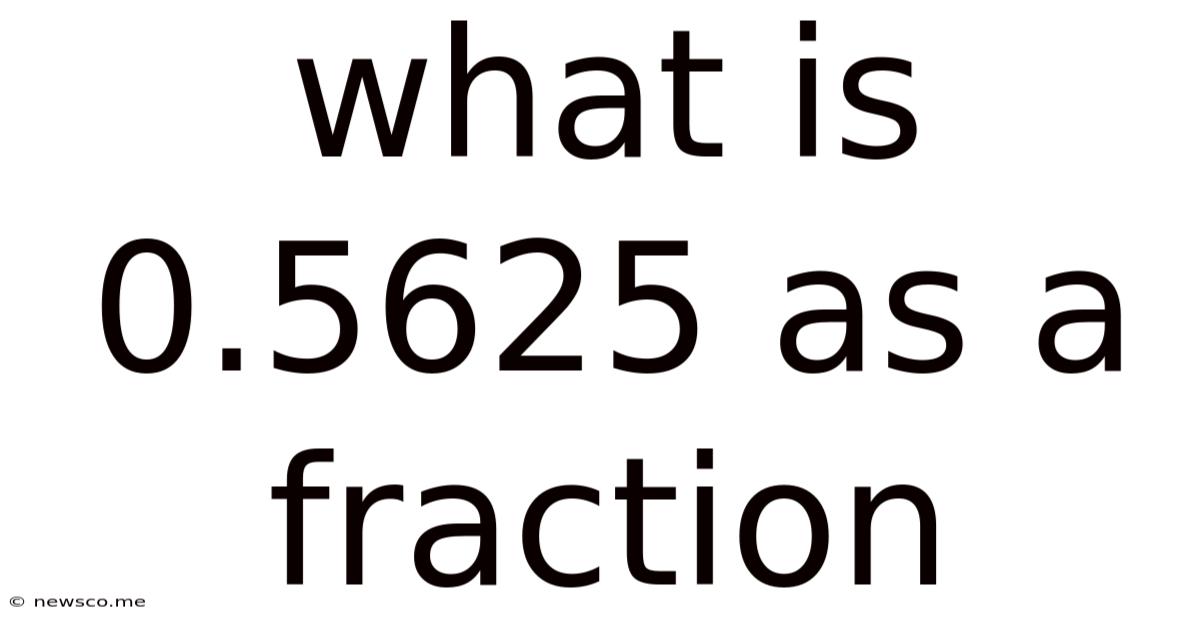What Is 0.5625 As A Fraction
News Co
Apr 01, 2025 · 4 min read

Table of Contents
What is 0.5625 as a Fraction? A Comprehensive Guide
Converting decimals to fractions might seem daunting at first, but with a systematic approach, it becomes a straightforward process. This comprehensive guide will walk you through the steps of converting the decimal 0.5625 into a fraction, explaining the underlying principles and providing additional examples to solidify your understanding. We'll also explore some advanced techniques and applications of this conversion.
Understanding Decimal to Fraction Conversion
The core principle behind converting a decimal to a fraction lies in recognizing the place value of each digit after the decimal point. Each place represents a power of 10: tenths (1/10), hundredths (1/100), thousandths (1/1000), and so on. By understanding this, we can express the decimal as a fraction with a denominator that is a power of 10.
Converting 0.5625 to a Fraction: Step-by-Step
Let's break down the conversion of 0.5625 into a fraction:
-
Identify the Decimal Places: 0.5625 has four decimal places. This means the denominator of our fraction will be 10<sup>4</sup>, which equals 10,000.
-
Write the Decimal as a Fraction: We can write 0.5625 as the fraction 5625/10000.
-
Simplify the Fraction: The crucial step is to simplify the fraction to its lowest terms. This involves finding the greatest common divisor (GCD) of the numerator (5625) and the denominator (10000) and dividing both by it.
To find the GCD, we can use the Euclidean algorithm or prime factorization. Let's use prime factorization:
- 5625 = 5<sup>4</sup> * 9
- 10000 = 2<sup>4</sup> * 5<sup>4</sup>
The only common factor is 5<sup>4</sup> = 625.
-
Divide Numerator and Denominator by the GCD:
5625 ÷ 625 = 9 10000 ÷ 625 = 16
Therefore, the simplified fraction is 9/16.
Verification: Converting the Fraction Back to a Decimal
To verify our conversion, we can divide the numerator (9) by the denominator (16):
9 ÷ 16 = 0.5625
This confirms that our fraction, 9/16, is the correct representation of the decimal 0.5625.
Alternative Method: Using the Place Value Directly
Instead of immediately writing the decimal as a fraction with a denominator of 10000, we can leverage the place value directly:
0.5625 = 5/10 + 6/100 + 2/1000 + 5/10000
Now, we find a common denominator, which is 10000:
= (5000 + 600 + 20 + 5)/10000 = 5625/10000
This simplifies, as we've shown before, to 9/16. This method highlights the fundamental understanding of decimal place values.
Advanced Techniques and Applications
While the basic method is sufficient for most conversions, understanding more advanced techniques can be beneficial:
-
Recurring Decimals: The methods described above primarily apply to terminating decimals (decimals that end). Recurring decimals (decimals that repeat infinitely) require a different approach, often involving solving an equation.
-
Improper Fractions and Mixed Numbers: If the numerator of the simplified fraction is larger than the denominator, you'll have an improper fraction. You can convert this to a mixed number (a whole number and a fraction) by performing division.
-
Scientific Applications: Decimal to fraction conversions are crucial in many scientific fields, including engineering, physics, and chemistry, where precise measurements and calculations are essential. Accuracy is paramount in these fields, making a solid understanding of these conversions vital.
-
Computer Programming: In computer programming, understanding decimal to fraction conversion is important for handling numerical data accurately and efficiently. Certain programming languages handle fractions more naturally than decimals, depending on the underlying data types used.
Practice Problems and Further Exploration
To solidify your understanding, try converting the following decimals to fractions:
- 0.375
- 0.625
- 0.875
- 0.125
- 0.75
Remember to simplify your fractions to their lowest terms. You can also explore online calculators or resources that provide step-by-step solutions to check your work and build your confidence.
Conclusion: Mastering Decimal to Fraction Conversions
Converting decimals to fractions is a fundamental mathematical skill with wide-ranging applications. By mastering this skill, you enhance your numerical literacy and problem-solving abilities. The step-by-step approach, along with the alternative method utilizing place values, provides a strong foundation for accurately and confidently converting decimals to fractions. Remember to always simplify your fractions to their lowest terms for the most concise representation. The practice problems provided should help solidify your understanding, allowing you to tackle more complex decimal-to-fraction conversions in the future with ease. This knowledge is valuable not only in mathematical contexts but also in practical real-world scenarios across various disciplines.
Latest Posts
Related Post
Thank you for visiting our website which covers about What Is 0.5625 As A Fraction . We hope the information provided has been useful to you. Feel free to contact us if you have any questions or need further assistance. See you next time and don't miss to bookmark.